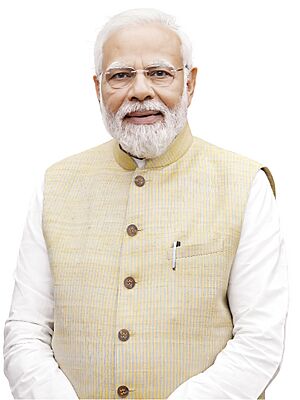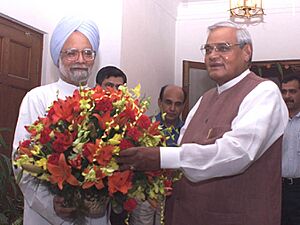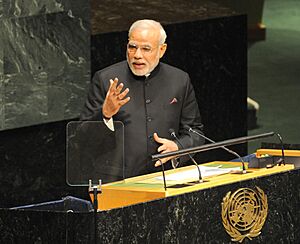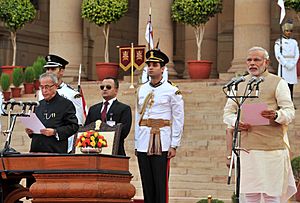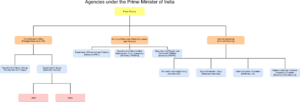Prime Minister of India facts for kids
Quick facts for kids Prime Minister of the Republic of India |
|
|---|---|

|
|

Logo of the Prime Minister of India
|
|
| Prime Minister's Office Union Council of Ministers Executive branch of the Indian Government |
|
| Style |
|
| Abbreviation | PM |
| Member of |
Parliament of India
Union Council of Ministers |
| Reports to | |
| Residence | 7, Lok Kalyan Marg, New Delhi, Delhi, India |
| Seat | Secretariat Building, New Delhi, Delhi, India |
| Nominator | Lok Sabha members |
| Appointer | President of India |
| Term length | At the pleasure of the president
|
| Constituting instrument | Articles 74 & 75, Constitution of India |
| Precursor | Vice President of the Executive Council |
| Formation | 15 August 1947 |
| First holder | Jawaharlal Nehru |
| Deputy | Deputy Prime Minister |
| Salary |
|
The Prime Minister of India is the main leader of the Government of India. They are like the head of the team that runs the country. Even though the President of India is the official head, the Prime Minister and their chosen group of ministers hold the real power.
The Prime Minister must be a member of one of the two houses of the Parliament of India. These houses are the Lok Sabha (House of the People) and the Rajya Sabha (Council of States). The Prime Minister and their cabinet are always answerable to the Lok Sabha.
The President of India appoints the Prime Minister. However, the Prime Minister must have the support of most members in the Lok Sabha. These members are chosen by people in elections held every five years. If the Prime Minister loses this support, they must resign. The Prime Minister decides who will be in their team of ministers and what jobs they will do.
India's first Prime Minister, Jawaharlal Nehru, served the longest. He was Prime Minister for over 16 years. After him, Lal Bahadur Shastri had a short term. Then, Indira Gandhi served two terms. Both were from the Indian National Congress party. After Indira Gandhi, her son Rajiv Gandhi became Prime Minister. The years after 1989 saw several different governments. Later, P. V. Narasimha Rao, Atal Bihari Vajpayee, and Manmohan Singh served full terms. Narendra Modi is the current Prime Minister of India. He has been in office since May 26, 2014. He is the first non-Congress leader to win three elections in a row (2014, 2019, 2024). Jawaharlal Nehru was the first to win three terms (1952, 1957, 1962).
Contents
- How the Prime Minister's Role Began
- Prime Minister's Role in the Government
- Becoming and Leaving the Prime Minister's Office
- What the Prime Minister Does
- Languages of the Prime Minister's Office Website
- Pay and Benefits
- Prime Minister's Family
- After Being Prime Minister
- Special Funds Managed by the Prime Minister
- Deputy Prime Minister
- See also
How the Prime Minister's Role Began
India uses a parliamentary system of government. In this system, the Prime Minister leads the government and is in charge of the executive branch. The head of state, like the President, usually has a more ceremonial role. They act on the advice of the Prime Minister.
If someone becomes Prime Minister but is not already a Member of Parliament, they must become one within six months. The Prime Minister works with other ministers to pass new laws in Parliament.
Prime Ministers from 1947 to 1984
Since 1947, India has had 14 different Prime Ministers. For many years after 1947, the Indian National Congress (INC) was the most powerful political party. Jawaharlal Nehru became India's first Prime Minister on August 15, 1947. He served for 17 years and won four general elections. He passed away in May 1964.
After Nehru's death, Lal Bahadur Shastri became Prime Minister. He was a leader of the Congress party. During his time, the Indo-Pakistani War of 1965 happened. Shastri died in Tashkent after signing a peace agreement.
Then, Indira Gandhi, Nehru's daughter, became India's third Prime Minister. She was the first and only woman to hold this position. Her first term lasted 11 years. During this time, banks were taken over by the government. Also, special payments to royal families from old kingdoms were stopped. Important events like the Indo-Pakistani War of 1971 and the creation of Bangladesh happened. India also conducted its first nuclear test in Pokhran. In 1975, a difficult period called the Emergency was declared. This gave the government special powers.
The Emergency ended in 1977, and a new election was held. Many opposition parties joined together as the Janata Party. They won the election and defeated the Congress party. Morarji Desai became the first non-Congress Prime Minister. His government had different groups that found it hard to work together. He resigned after two and a half years. Then, Charan Singh became Prime Minister with support from Congress. But Congress soon withdrew its support, and Singh had to resign. His term was only 5 months, the shortest ever.
In 1980, the Congress party returned to power, and Indira Gandhi became Prime Minister again. In June 1984, the Indian Army carried out Operation Blue Star at the Golden Temple. On October 31, 1984, Indira Gandhi was assassinated by her bodyguards.
Prime Ministers from 1984 to 1999
After Indira Gandhi, her eldest son, Rajiv Gandhi, became Prime Minister. He was 40 years old, making him the youngest Prime Minister ever. In the 1984 election, the Congress party won a huge victory, getting 401 out of 552 seats. This was the most seats any party had ever won.
Later, V. P. Singh, who was a minister in Rajiv Gandhi's government, found problems in a defense deal. He left Congress and formed a new party, Janata Dal. He also created a group of parties called the National Front.
In the 1989 election, the National Front came to power, and V. P. Singh became Prime Minister. His government accepted important recommendations for social justice. However, his term ended when a major party supporting his government withdrew its help. V. P. Singh lost a vote of no confidence and resigned.
After V. P. Singh, Chandra Shekhar became Prime Minister with support from Congress. But Congress soon withdrew its support, and his government also fell. New elections were called.
Rajiv Gandhi was assassinated during the 1991 election campaign. The Congress party, led by P. V. Narasimha Rao, won the election. Rao became the first Prime Minister from South India. India was facing economic challenges, so Rao started major economic reforms. He appointed Manmohan Singh, an economist, as Finance Minister. Their efforts led to strong economic growth. However, during his time, the demolition of the Babri Masjid also happened, leading to violence. Rao completed a full five-year term, the first Prime Minister outside the Nehru–Gandhi family to do so.
After Rao's term ended in May 1996, India had four Prime Ministers in three years. These included two terms of Atal Bihari Vajpayee, and terms by H. D. Deve Gowda and I. K. Gujral. In May 1998, Prime Minister Vajpayee's government conducted five underground nuclear tests in Pokhran. Many Western countries put economic restrictions on India. However, with support from other nations, these restrictions were not very effective. Pakistan also conducted nuclear tests in response. To improve relations, India and Pakistan signed the Lahore Declaration in 1999.
In May 1999, a key party left Vajpayee's government. His government lost a vote of no confidence and became a temporary government. This happened during the Kargil War with Pakistan. In the October 1999 election, Vajpayee's party and its allies won a clear majority.
Prime Ministers from 2000 to Present
Vajpayee continued economic reforms, leading to more economic growth. His government also worked on improving roads and infrastructure across the country. However, the 2002 Gujarat riots also occurred during his time. Vajpayee completed a full five-year term, becoming the first non-Congress Prime Minister to do so.
In the 2004 election, the Congress party became the largest party. They formed a group called the United Progressive Alliance (UPA) and gained enough support to form the government. Manmohan Singh became Prime Minister, the first Sikh to hold the position. During his time, India continued its economic growth. His government passed important laws like the National Rural Employment Guarantee Act, 2005 and the Right to Information Act, 2005. India also strengthened its relationships with many countries. However, the 2008 Mumbai attacks also happened during his first term.
In the 2009 election, the UPA won even more support. Prime Minister Singh's second term faced accusations of corruption. He resigned on May 17, 2014, after Congress lost the 2014 election.
In the 2014 election, the Bharatiya Janata Party (BJP) and its allies won a clear majority. The BJP became the first party since 1984 to win a majority on its own. Narendra Modi, who was then the Chief Minister of Gujarat, became Prime Minister. He was the first Prime Minister born after India became independent.
Narendra Modi was re-elected as Prime Minister in 2019 with an even bigger victory. The BJP and its allies won 354 seats, with the BJP alone securing 303 seats. He was re-elected for a third term in 2024.
Political Parties of Prime Ministers
| Party | PMs | Years in Office | Name(s) | Alliance | |
|---|---|---|---|---|---|
| Indian National Congress | 6 | 54 years | Jawaharlal Nehru, Lal Bahadur Shastri, Indira Gandhi, Rajiv Gandhi, P. V. Narasimha Rao and Manmohan Singh | ||
| Bharatiya Janata Party | 2 | 17 years | Atal Bihari Vajpayee and Narendra Modi | NDA (from 1998) | |
| Janata Dal | 3 | 2 years | Vishwanath Pratap Singh, H. D. Deve Gowda and Inder Kumar Gujral | NF (1989–1990) UF (1996–1998) | |
| Janata Party | 1 | 2 years | Morarji Desai | JP | |
| Janata Party (Secular) | 1 | <1 years | Charan Singh | ||
| Samajwadi Janata Party (Rashtriya) | 1 | <1 years | Chandra Shekhar | JP
External support from INC |
|
Prime Minister's Role in the Government
The Constitution of India says that the President of India is the head of the country. The Prime Minister leads a group of ministers who help and advise the President. This means the Prime Minister has the main responsibility for running the government.
The President's duties are mostly ceremonial. They act on the advice of the Prime Minister and the cabinet. The Prime Minister's role is very important because they usually have the support of the majority in the Lok Sabha.
Becoming and Leaving the Prime Minister's Office
Who Can Be Prime Minister?
To become Prime Minister, a person must:
- Be a citizen of India.
- Be a member of either the Lok Sabha or the Rajya Sabha. If they are not, they must become a member of one of these houses within six months of becoming Prime Minister.
- Be at least 25 years old if they are a Lok Sabha member.
- Be at least 30 years old if they are a Rajya Sabha member.
- Not hold any other paid government job.
Once someone becomes Prime Minister, they must leave any jobs they had in private or government companies.
Taking the Oath
Before starting their job, the Prime Minister takes an oath in front of the President of India. They promise to be loyal to the Constitution and to do their duties honestly and fairly. They also promise to keep government secrets.
How Long Does a Prime Minister Serve?
A Prime Minister serves as long as the President has confidence in them. However, more importantly, they must keep the support of the Lok Sabha.
A Prime Minister's term can end early if most members of the Lok Sabha no longer support them. This is called a vote of no confidence. Three Prime Ministers, I. K. Gujral, H. D. Deve Gowda, and Atal Bihari Vajpayee, lost their jobs this way. A Prime Minister can also choose to resign. Morarji Desai was the first Prime Minister to resign while in office.
What the Prime Minister Does
Leading the Government
The Prime Minister leads how the Indian government works. The President invites the person who has the support of most Lok Sabha members to form the government. The Prime Minister then chooses the members of their council of ministers. They also pick a smaller group of important ministers, called the cabinet, to lead key government departments.
The Prime Minister helps the President decide how government work is divided among different ministries. The Prime Minister also attends Parliament sessions and answers questions from Members of Parliament about their work.
Some important government departments are directly managed by the Prime Minister. These usually include:
- Ministry of Personnel, Public Grievances and Pensions
- Cabinet Secretariat
- Appointments Committee of the Cabinet
- Cabinet Committee on Security
- NITI Aayog (a policy think tank)
- Department of Atomic Energy
- Department of Space
- Nuclear Command Authority
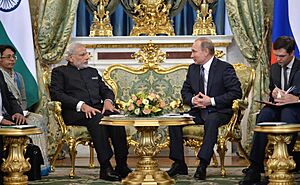
The Prime Minister represents India in important meetings and organizations around the world. They also speak to the nation about important issues.
Power to Appoint Officials
The Prime Minister suggests names to the President for many important government positions, such as:
- Chief Election Commissioner
- Head of the Union Public Service Commission
- Attorney General of India
The Prime Minister also decides where top government officers and military leaders will be posted. This includes the heads of the Army, Navy, and Air Force.
However, the Prime Minister does not have much say in choosing judges. That is done by a group of judges themselves.
Power to Make Laws
The Prime Minister is the leader of the house of Parliament they belong to, usually the Lok Sabha. They represent the government in Parliament, announce new laws, and respond to questions from the opposition parties. The Prime Minister also has a say in when Parliament sessions are held.
Languages of the Prime Minister's Office Website
The official website of the Prime Minister's Office is available in 12 Indian languages, besides English and Hindi. These languages are:
- Assamese
- Bengali
- Gujarati
- Kannada
- Malayalam
- Manipuri
- Marathi
- Odia
- Punjabi
- Tamil
- Telugu
- Urdu
You can find these language versions on the official website.
Pay and Benefits
The Parliament decides the Prime Minister's salary and other benefits. In 2010, it was reported that the Prime Minister receives monthly allowances rather than a formal salary. Compared to other world leaders, the Indian Prime Minister's pay is quite low when considering the country's economic size.
Where the Prime Minister Lives
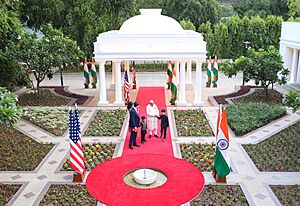
The official home of the Prime Minister of India is 7, Lok Kalyan Marg in New Delhi.
The first Prime Minister, Jawaharlal Nehru, lived at Teen Murti Bhavan. Later Prime Ministers lived in different homes. Rajiv Gandhi was the first to use 7, Lok Kalyan Marg as his official residence.
How the Prime Minister Travels
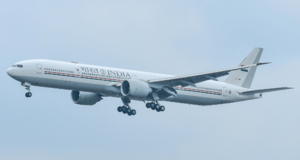
For travel on the ground, the Prime Minister uses a special armored Range Rover. Their motorcade includes many security vehicles.
For air travel, the Prime Minister uses special Boeing 777-300ER planes called Air India One. These planes are operated by the Indian Air Force. Helicopters are used for shorter trips.
Prime Minister's Security
The Special Protection Group (SPG) is responsible for protecting the Prime Minister and their family. Other police forces also help with security.
Prime Minister's Office
The Prime Minister's Office (PMO) is where the Prime Minister works. It is located in South Block in New Delhi. This office is led by the Principal Secretary to the Prime Minister, who is usually a former government officer.
Prime Minister's Family
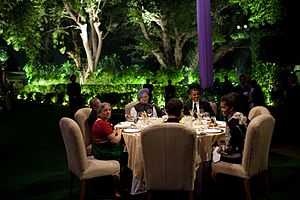
The Prime Minister's spouse sometimes travels with them on visits to other countries. The Prime Minister's family used to receive protection from the Special Protection Group, but this was changed in 2019. The Nehru–Gandhi family is famous for having three Prime Ministers: Jawaharlal Nehru, Indira Gandhi, and Rajiv Gandhi. Many family members of former Prime Ministers are also involved in politics.
After Being Prime Minister
Former Prime Ministers receive a house and other benefits similar to a serving cabinet minister for five years. This includes staff and travel tickets.
They also rank high in the Indian order of precedence. As former Members of Parliament, they receive a pension after leaving office. Some former Prime Ministers, like H. D. Deve Gowda, continue to be Members of Parliament.
Death of a Prime Minister
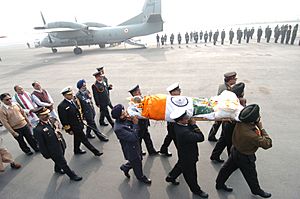
When a Prime Minister passes away, they are given a state funeral. It is common for states and union territories to declare a day of mourning.
Remembering Prime Ministers
Many places and institutions are named after India's Prime Ministers. For example, Jawaharlal Nehru's birthday is celebrated as Children's Day. Charan Singh's birthday is celebrated as Farmer's Day. Prime Ministers are also honored on postage stamps.
Special Funds Managed by the Prime Minister
The Prime Minister oversees several important funds.
National Defence Fund
The National Defence Fund (NDF) was started in 1962 after the war with China. The Prime Minister leads this fund, which helps with national defense. It relies on donations from the public and does not get money from the government budget. Donations to this fund are tax-deductible.
Prime Minister's National Relief Fund
The Prime Minister's National Relief Fund (PMNRF) was set up in 1948 to help people displaced from Pakistan. Today, it mainly helps families affected by natural disasters like earthquakes and floods. It also helps people with serious illnesses pay for medical care. Donations to this fund are also tax-deductible.
PM CARES Fund
In March 2020, during the COVID-19 pandemic, Prime Minister Narendra Modi announced the creation of the PM CARES Fund. This fund was set up to help with emergencies like the pandemic. It is entirely based on voluntary donations from the public. The fund was used to buy medical supplies and support vaccine research.
Deputy Prime Minister
The role of Deputy Prime Minister is not officially mentioned in the Constitution. However, throughout history, some governments have appointed a senior minister to this position. This role does not come with special powers. Usually, important ministers like the Finance Minister or Home Minister are chosen as Deputy Prime Minister. This position is seen as the second most important in the cabinet and can represent the government when the Prime Minister is away. Deputy Prime Ministers are often appointed to help strengthen coalition governments.
See also
 In Spanish: Primer ministro de la India para niños
In Spanish: Primer ministro de la India para niños


